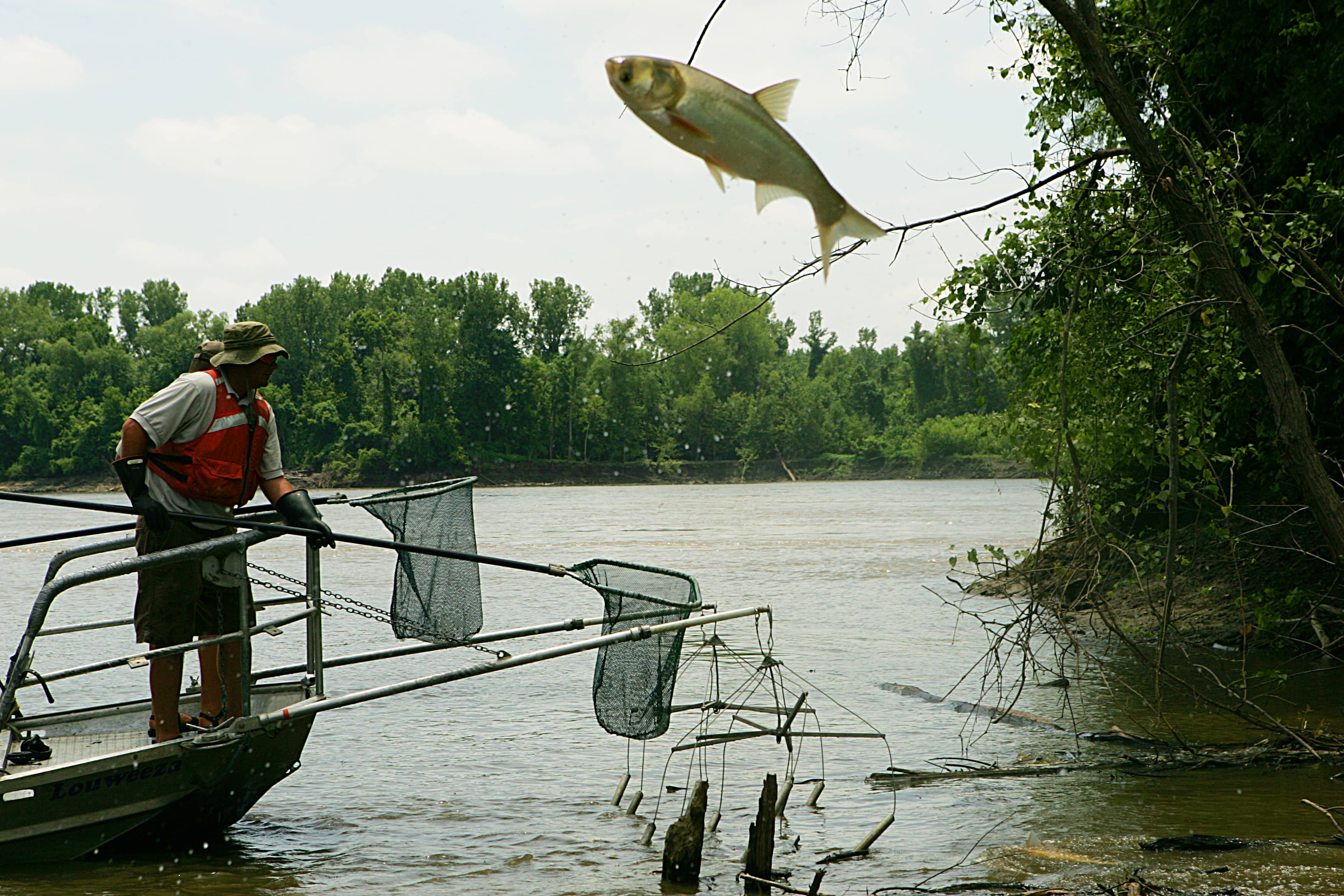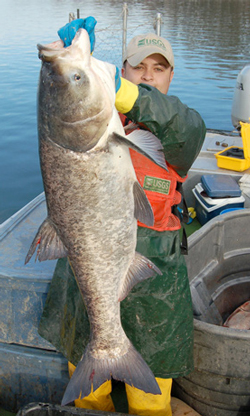The Asian Carp Invasion of the Great Lakes
James Swan 04.26.13

They’re Coming! No, They’re Already Here! Maybe?
The Great Lakes are threatened with an exotic invasive species AGAIN. First it was the sea lamprey, an aquatic parasitic eel that found its way into Lake Erie through the Welland Canal in the 1920s and spread to lakes St. Clair, Michigan, Huron, and Superior with devastating consequences. In the early part of the 20th century, sea lampreys essentially wiped out lake trout and whitefish populations in the Great Lakes.
The next major invasive species to slip in the same way was the alewife, a fat, prolific minnow. Without the apex predator lake trout in the nutrient-rich waters of the 1950s and 1960s, alewife populations exploded, resulting in mounds of small, oily fish washing up on beaches. I well remember my high school senior class trip in 1961 taking a boat from Chicago to Detroit. As we cruised through Lakes Michigan and Huron, we were never out of sight of streams of dead alewives floating on the surface.
After the lampreys were brought under control, salmon were planted, and lake trout and whitefish began to recover and the alewife population declined as salmon and lake trout flourished on the alewives. A new recreational and commercial fishery blossomed.
The third strike against the Great lakes came from tiny quagga and zebra mussels that smuggled their way through the Welland Canal in the ballast waters of foreign ships in 1989. An extremely prolific species without any predators in the Great Lakes ecosystem, the tiny mollusks soon covered water intakes and ravished phytoplankton needed for all small fish. Damage to water intakes alone from quagga and zebra mussels cost over $5 billion in the 1990s.
The Aquatic Nuisance Prevention and Control Act was passed in 1990, and mandates ballast water exchange of all salt water vessels entering the St. Lawrence Seaway. In 1996, the National Invasive Species Act of 1996 was passed, the U.S. federal bill to reauthorize and expand the 1990 federal nonindigenous species legislation. This is helping, but the new species that seems itching to get into the Great Lakes is not going to get in via ballast waters.
There are now a total of 160 non-native invasive species currently in the Great Lakes: lampreys, alewives, zebra and quagga mussels, Eurasian ruffe, round goby, spiny waterflea, etc., and they already have a significant negative impact on the ecology and economy of the Great Lakes region. Some estimates place it in the billions of dollars per years. But the new invader that has the potential to have as big a negative impact as the sea lamprey or alewife, maybe much bigger, is at the door.
The new invasive species is Asian carp, and if they get established in the Great Lakes, the damage will be the most costly of all and the hardest to deal with, because these fish are so prolific and their voracious appetite will consume huge amounts of plankton that supports all life in the entire Great Lakes ecosystem.
Of carp, common and otherwise
Common carp (Cyprinus carpio) are a Eurasian fish species that are valued abroad for food and sport. In 1831 the common carp was introduced into U.S. waters. Common carp have spread, legally and illegally, across North America. They are now found in all 50 states, Mexico, and most Canadian provinces. Its value for food and sport have never really taken hold here and they are now classified as a trash fish in most places, despite the efforts of some dedicated carp fishermen. There is a growing group of positive thinkers who are organizing carp fishing tournaments, and there is even something called “The Carp Channel.”

Yes, they do fight. And, in my experience, when you catch carp right after the spring thaw, their flesh is delicious when smoked. However, I well recall growing up on the lower Detroit River, when shooting carp with bow and arrow was a popular pastime for many. A major event every year was the carp bowfishing derby held at Pointe Mouillee State Game Area. My biggest was 32 pounds.
These Asian carp are a very different species.
The Chinese have been growing several carp species for food for thousands of years. Chinese culture, in fact, sees carp as an auspicious sign of good luck (this is why carp aquariums are located in some Chinese restaurants) and they are cultivated for food and for fish ponds, as well as living in rivers and lakes. In the 1960s grass carp were introduced into the U.S. This was followed by introductions of black carp, silver carp, and bighead carp, to join already established European carp, and goldfish, which escaped into the wild and grew rapidly.
Asian carp were initially planted in the southern U.S. to clean out excessive algae in fish farms and sewage treatment plants and to serve as a source of food, primarily for Asian markets. These fish are very good at being living vacuum cleaners and they grow rapidly. Flooding in the 1990s resulted in Asian carp escaping into the Mississippi River system, where they have reproduced and spread northward. They are now the most abundant large fish in the lower Missouri River.
The EPA, NOAA, U.S. Fish and Wildlife Service, and many other resource management agencies are very concerned about the spread of these invasive species. Bighead carp can grow to 100 pounds and four feet in length. A filter feeder, they can eat up to 40% of their body weight daily. Silver carp, another filter feeder, can grow to 40 pounds and leap out of the water up to 8-10 feet in the air when boats approach. Forget waterskiing, speed boats, and jetskis in any body of water where silver carp get established. Numerous boaters have been harmed by jumping silver carp. Yes, you can run a boat through the carp and they jump out of the water, making them exciting targets for bowfishing, but this is not going to make a dent in their numbers.
Bighead and silver carp are filter feeders and will definitely reduce the available plankton for all fish. By inhaling huge amounts of plankton they quickly become the most dominant fish in that ecosystem. Neither can be caught by conventional sport fishing methods. Black carp eat snails and mussels, and are only found in ponds to date.
In July 2007, all silver carp and largescale silver carp were declared by the U.S. Department of the Interior to be invasive species under the Lacey Act.
Searching for a Great Wall
Over $20 million has been spent on electric fish fences to try to stop the movement of the carp in the ship canals of the Illinois River, which connects to Lake Michigan. Still, traces of Asian carp DNA have been found in Lake Michigan. If Asian carp get through the locks on the Illinois River and become established in the Great Lakes, it could devastate the $7 billion sport and commercial fishery in the Great Lakes by outcompeting with the desirable fish. The ripple effects of the loss of thousands of jobs and to the economy in general are huge.

On December 21, 2009, Michigan Attorney General, Mike Cox filed a lawsuit with the U.S. Supreme Court to make Illinois and the U.S. Army Corps of Engineers prevent Asian carp getting into Lake Michigan through the shipping canal that links the Great Lakes with the Mississippi River system. The suit calls for closing and ceasing operation of the O’Brien Lock and the Chicago Lock, operating sluice gates to prevent carp from entering the lake, and installing barriers to prevent them from getting into Lake Michigan. Five other states joined with Cox’s lawsuit.
On January 19, 2010 the U.S. Supreme Court rejected the Michigan injunction request, and took no action on Michigan’s separate request to reopen older cases regarding Chicago water withdrawl from Lake Michigan. Another appeal was rejected in December of 2012.
Considering how the economic downturn has affected the automobile industry and the Michigan economy, all Michigan needs is another blow to the economy. And the effects of an Asian carp invasion of the Great Lakes go much further, impacting the economies of Ontario, Wisconsin, Illinois, Indiana, Ohio, and Pennsylvania.
Numerous studies have already detected Asian carp DNA in the Great Lakes, including recent research where it was found in beach soil along lakes Michigan and Erie, presumably carried in by bird poop. Whether the fish are there remains to seen.
Strategies abound to either prevent Asian carp from getting into the Great Lakes, or managing them if they do. Putting physical and/or electrical barriers on streams is one of the big ones. One of the most interesting recent innovative approaches is the “Judas fish” where a carp is caught and tagged with a device that can be tracked from the air. Counting on the fish schooling, the Judas carp is tracked via a helicopter and then huge nets are set to ensnare the entire school of fish.
Yes, Asian carp are edible (fish sticks anyone?), and can certainly be used for fertilizer and animal feed. But a massive carp fishery will not replace the value of current sport and commercial fisheries. Asian carp cannot be caught by conventional sport fishing techniques, except bowfishing.
Kentucky has a novel idea for Asian carp control. The Carp Madness Tournament offers a $10,000 prize for the commercial fishing team that brings in the most fish. Yes, you could do things like this for the Great Lakes, but they are way to big to expect serious control from carp tournaments.
Budgeting to control–but not to educate?
The Asian carp are, however, are already creating jobs in the Great Lakes region. In 2011 the federal budget for carp control and management was $47 million. In 2012, the Obama administration allocated $51.5 million for Asian carp control, much of the money devoted to monitoring waters to detect the presence of the carp.
As I study the budgets, while they support some worthy research, what emerges is a very strange void. No money seems to be allocated to educating the general public about the problem and what simple steps can be taken to avoid helping the spread of the fish. Can science and law do it all? I sincerely doubt it. Build all the barriers you want. Someone decides to catch some small carp in the Illinois River for an aquarium, they get too big, and so they dump the poor fishies in Lake Michigan. Game over.
I confess, the failure to fund public Asian carp education efforts has a personal side to it. Michigan film and TV producer Bob Brown and I have been trying for over three years to find funding for a major documentary about the Asian carp invasion, what it is, and how people can step up to help prevent it. We have talked with some nice people, but not a dollar has been located that could go to fund such a worthy project. While I cannot divulge more about the film itself, I can tell you that we have been in talks with some major celebrities to narrate the pic. Too bad David Carradine is no longer with us. Can’t you see “Kwai Chang Caine” leading the fight against Asian carp?

